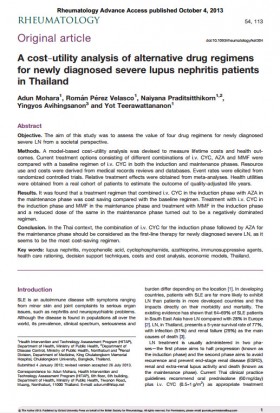This website uses cookies so that we can provide you with the best user experience possible. Cookie information is stored in your browser and performs functions such as recognising you when you return to our website and helping our team to understand which sections of the website you find most interesting and useful.
A cost – utility analysis of alternative drug regimens for newly diagnosed severe lupus nephritis patients in Thailand. (2013)

Details
Abstract
OBJECTIVE:
The aim of this study was to assess the value of four drug regimens for newly diagnosed severe LN from a societal perspective.
METHODS:
A model-based cost-utility analysis was devised to measure lifetime costs and health outcomes. Current treatment options consisting of different combinations of i.v. CYC, AZA and MMF were compared with a baseline regimen of i.v. CYC in both the induction and maintenance phases. Resource use and costs were derived from medical records reviews and databases. Event rates were elicited from randomized controlled trials. Relative treatment effects were obtained from meta-analyses. Health utilities were obtained from a real cohort of patients to estimate the outcome of quality-adjusted life years.
RESULTS:
It was found that a treatment regimen that combined i.v. CYC in the induction phase with AZA in the maintenance phase was cost saving compared with the baseline regimen. Treatment with i.v. CYC in the induction phase and MMF in the maintenance phase and treatment with MMF in the induction phase and a reduced dose of the same in the maintenance phase turned out to be a negatively dominated regimen.
CONCLUSION:
In the Thai context, the combination of i.v. CYC for the induction phase followed by AZA for the maintenance phase should be considered as the first-line therapy for newly diagnosed severe LN, as it seems to be the most cost-saving regimen.
Please click here to access the paper.
http://rheumatology.oxfordjournals.org/content/early/2013/10/04/rheumatology.ket304.abstract




